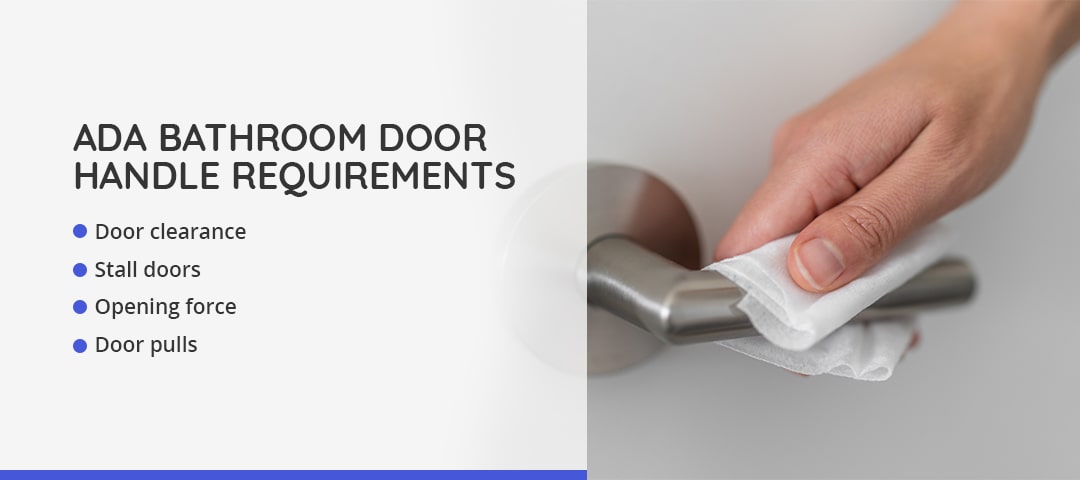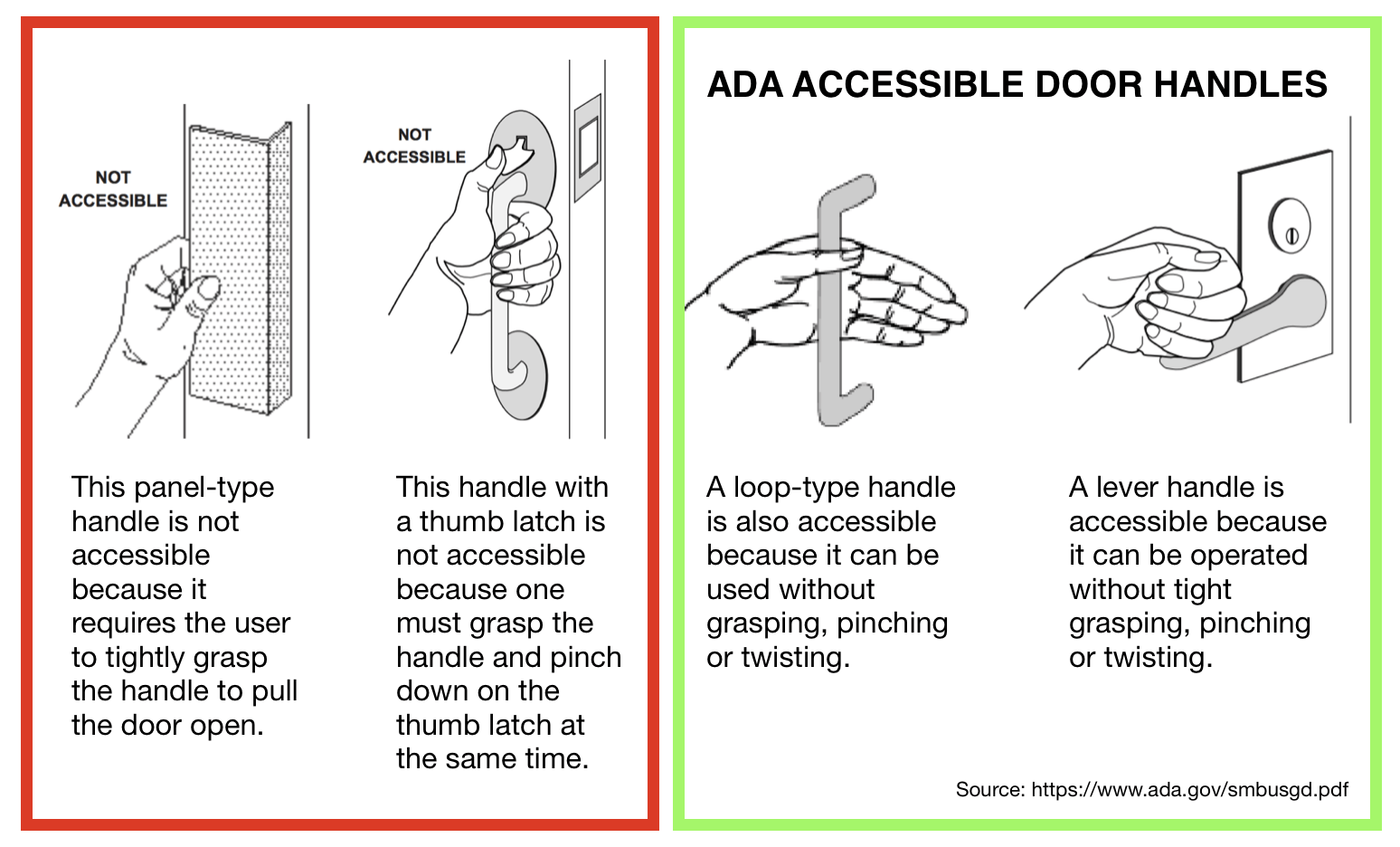ADA Bathroom Door Handle Requirements

The Americans with Disabilities Act (ADA) sets standards for accessibility in public and commercial buildings, including bathroom facilities. These regulations ensure that individuals with disabilities can use these facilities safely and independently. This guide will explore the specific requirements for bathroom door handles under the ADA, focusing on their design and function.
ADA Standards for Bathroom Door Handles, Ada bathroom door handle requirements
ADA standards for bathroom door handles focus on ease of use and accessibility. The regulations aim to ensure that individuals with disabilities can easily open and close doors, regardless of their physical limitations. Key aspects of these standards include:
- Lever Handles: ADA regulations require the use of lever handles for bathroom doors. Lever handles are easier to operate than traditional knob handles, as they require less force and dexterity to manipulate. They are particularly beneficial for individuals with limited hand strength, mobility issues, or arthritis.
- Handle Height: The ADA specifies a minimum height of 34 inches (86.4 cm) and a maximum height of 48 inches (121.9 cm) for lever handles. This range ensures that the handles are accessible to individuals of varying heights, including those who use wheelchairs. The placement of the handle within this range should be determined by the specific needs of the facility and its users.
- Handle Projection: The ADA requires a minimum projection of 1 1/2 inches (3.8 cm) for lever handles. This projection ensures sufficient clearance for individuals with limited reach to grasp the handle and operate the door.
- Handle Force: The ADA sets a maximum force requirement of 5 pounds (22.7 N) for lever handles. This ensures that individuals with limited hand strength can easily operate the door.
- Handle Design: ADA standards specify that lever handles should be designed with a smooth, rounded shape and a clear tactile contrast with the surrounding door. This allows for easy identification and manipulation by individuals with visual impairments.
Historical Context and Evolution of ADA Regulations
The ADA was enacted in 1990, and it has undergone several revisions and updates over the years. The initial regulations focused on accessibility for individuals with physical disabilities, but subsequent updates have expanded the scope to include individuals with sensory, cognitive, and other disabilities.
- Early Regulations: Early ADA regulations for bathroom door handles were primarily focused on the use of lever handles instead of knobs. This shift aimed to make doors easier to operate for individuals with limited hand strength or dexterity.
- Focus on Universal Design: Later updates to the ADA regulations incorporated the principles of universal design. This approach emphasizes creating environments that are accessible and usable by individuals of all abilities. This shift resulted in more specific guidelines for handle height, projection, and force requirements, ensuring that bathroom doors are accessible to a wider range of users.
- Ongoing Evolution: The ADA continues to evolve as technology advances and our understanding of accessibility needs expands. Future updates may include incorporating new materials and designs that further enhance the accessibility of bathroom doors for individuals with disabilities.
Key Requirements for ADA Bathroom Door Handles

Ada bathroom door handle requirements – Ensuring accessibility in public and private spaces is crucial for inclusivity. The Americans with Disabilities Act (ADA) establishes guidelines for accessible design, including requirements for bathroom door handles. These requirements aim to provide individuals with disabilities, particularly those using wheelchairs, with ease of access and independent use of facilities.
Lever Handle Design Requirements
ADA-compliant bathroom door handles must meet specific design criteria to ensure ease of use for individuals with varying abilities. These requirements focus on factors like grip strength, reach, and activation force, making it easier for people with limited mobility to open doors.
- Grip Strength: Lever handles must be designed to accommodate individuals with reduced grip strength. The handle should have a wide, contoured surface that allows for a comfortable and secure grasp, minimizing the need for excessive force.
- Reach: The lever handle should be positioned at a height that is easily accessible to individuals in wheelchairs. The ADA specifies a maximum reach height of 48 inches (122 cm) from the finished floor to the center of the handle. This ensures that individuals in wheelchairs can comfortably reach and operate the handle.
- Activation Force: The force required to activate the lever handle should be minimal. The ADA recommends a maximum activation force of 5 pounds (22.7 N). This ensures that individuals with limited hand strength can easily open the door without excessive effort.
Door Handle Placement and Clearance
Proper placement of the door handle is critical for wheelchair accessibility. The ADA provides guidelines for door handle placement and clearance to ensure smooth movement and maneuverability for wheelchair users.
- Door Handle Height: The lever handle should be positioned between 34 and 48 inches (86.4 to 121.9 cm) from the finished floor. This range allows for comfortable reach and operation by individuals of varying heights, including those using wheelchairs.
- Clearance: A minimum clearance of 32 inches (81.3 cm) is required between the door and any obstruction, such as a wall or fixture, to allow sufficient space for wheelchair access. This ensures that individuals in wheelchairs can approach the door, maneuver their chairs, and open the door without encountering obstacles.
Types of ADA Bathroom Door Handles: Ada Bathroom Door Handle Requirements

When it comes to designing accessible bathrooms, choosing the right door handles is crucial. ADA-compliant bathroom door handles are designed to be easy to use for people with disabilities, promoting independence and safety. Let’s explore the different types of ADA-compliant bathroom door handles available, their advantages and disadvantages, and the considerations for installation.
Lever Handles
Lever handles are the most common type of ADA-compliant bathroom door handle. They are designed to be operated with a simple push or pull motion, making them easy to use for people with limited hand strength or dexterity.
- Advantages:
- Easy to operate with minimal effort.
- Widely available in various styles and finishes.
- Suitable for both interior and exterior doors.
- Disadvantages:
- May not be suitable for doors with high traffic or heavy use.
- Can be prone to damage or wear over time, especially if used frequently.
- Installation:
- Lever handles are typically installed using standard door hardware.
- Ensure the lever handle is positioned at a height that is accessible for wheelchair users, typically between 34 and 48 inches from the floor.
Push Plates
Push plates are another popular option for ADA-compliant bathroom door handles. They are typically installed on the exterior side of the door and are designed to be activated by a simple push.
- Advantages:
- Easy to operate with minimal effort.
- Suitable for doors with high traffic or heavy use.
- Available in various materials and finishes.
- Disadvantages:
- May not be suitable for all door types, especially those with limited space.
- Can be more difficult to install than lever handles.
- Installation:
- Push plates are typically installed using screws or adhesives.
- Ensure the push plate is positioned at a height that is accessible for wheelchair users.
Pull Handles
Pull handles are another type of ADA-compliant bathroom door handle. They are typically installed on the interior side of the door and are designed to be operated by pulling a lever or handle.
- Advantages:
- Easy to operate with minimal effort.
- Suitable for doors with high traffic or heavy use.
- Available in various materials and finishes.
- Disadvantages:
- May not be suitable for all door types, especially those with limited space.
- Can be more difficult to install than lever handles.
- Installation:
- Pull handles are typically installed using screws or adhesives.
- Ensure the pull handle is positioned at a height that is accessible for wheelchair users.
ADA bathroom door handle requirements are designed to ensure accessibility for all, including those with mobility limitations. A critical consideration in achieving this is the direction the door swings, as it can significantly impact ease of access. While many bathrooms feature doors that swing inward, can a bathroom door swing out ?
The answer is yes, and in some cases, an outward swing might be preferable, especially for those who use mobility aids. This can allow for a wider entryway and greater maneuverability, further enhancing the ADA compliance of the bathroom design.
ADA bathroom door handle requirements ensure accessibility for everyone, a principle that resonates with the welcoming atmosphere of a st louis blues bathroom , where fans gather to celebrate their shared passion. These requirements, focusing on lever handles and proper grip, promote inclusivity, much like the spirit of the Blues themselves.